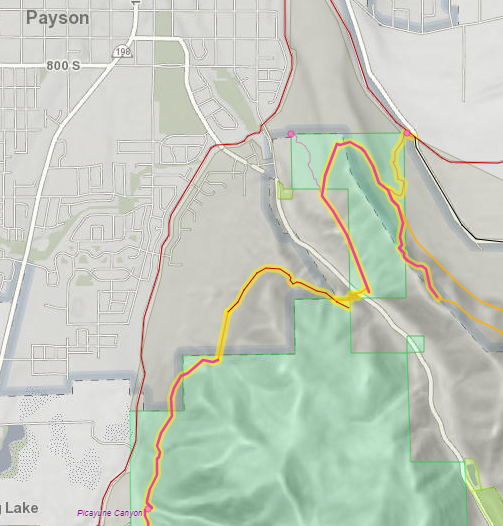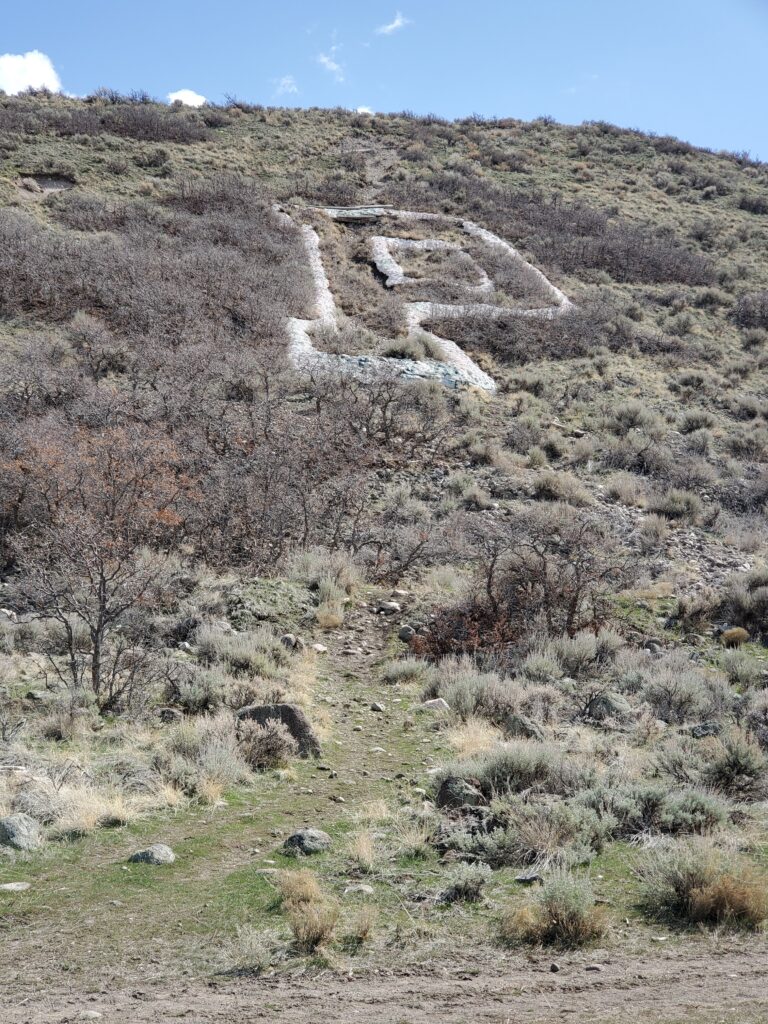6 miles (0 miles official BST, 5 miles unofficial route)

Today’s trek looped around the edge of Payson, with several very nice trail sections that have good potential for becoming the Bonneville Shoreline Trail, but there are a few access issues that may keep the status quo without funding or other changes.
Starting at Picayune Canyon, we climbed onto a very narrow band of the Bonneville bench within the National Forest (although we hardly saw a tree all day). The trail on the bench is very nice, if a bit faint, but both of the two trails climbing up are unsustainable steep; we would probably need some switchbacks here. Three ravines along the way had poor crossings, but between them the views of Spring Lake and southern Payson (including the LDS Temple) were spectacular.
North of the third ravine, the route crossed into private property. This area has been generally closed to the public, but the new landowner is potentially interested in trails and open space, and we were able to get permission to explore. The best route for the BST through here follows the road along a natural gas pipeline, nice and level. As it wrapped around the north end of Dry Mountain, we finally were in some trees, a very nice trail. We hit a narrow band of Forest Service land before a private property fence stopped our progress. This narrow band crosses Payson Canyon, so we decided to do a bit of bushwhacking to see if we could cross on public land. The short answer was “yes,” the long answer was “hardly.” We had to drop 200ft down an extremely steep slope, then we had to cross Canyon Road, then Peteetneet Creek (building our own temporary crossing with a log). So yeah, we could get a public land trail through here, but it would be challenging and expensive.

Now on the flanks of Tithing Mountain, we climbed another gas line utility road up to P Hill. These utility lines often look like promising trail routes because they are nice and straight, but that often means they go straight up and down steep hills; this stretch would need rerouting in places to be usable. P Hill is an “island” of public (Forest Service) land, which should make trail designation possible, except that all four of the current trails that enter it pass through a small stretch of private property: in some cases, no more than 100ft. Only one of the four (in the northwest corner, just off Canyon Road) currently appears to be unrestricted. The one in the northeast corner, on Goosenest Road, just about touches the road, except that you have to cross the Highline Canal, which is not safe. Fortunately, as we ended our hike today, it was still dry.
Passing the base of the P brought to mind the history of these “geoglyphs,” and my obsession many years ago with attempting to “geo-collect” all of the hillside letters in the Western U.S. I eventually mapped over 500 of them. We’ll see several more close up along our journey.
From the east side of P Hill, the future route of the BST through Elk Ridge, Woodland Hills, and Salem is much less clear, with three options:
- Most city and county plans have it as a paved bike path along the Strawberry Highline Canal, much like the Murdock Canal trail in the northern part of the County. This will be a great trail, and worth doing eventually, but it will be insanely expensive and is not really the character of the BST. Currently, a gravel road follows along the canal, but it is clearly posted no trespassing at every road crossing.
- The second option is to keep the wildland-urban interface character of the trail by wrapping around the upper reaches of Elk Ridge and Woodland Hills, at the base of the steep mountains. This will be a beautiful route, but it is a very long stretch of new construction, and almost all of the route passes through private property, including several who have actively restricted public access. Also, this would require a significant climb above the actual shoreline, with the upper edges of Woodland Hills being above 6,000ft. Future suburban development in those hills may make some of this trail possible.
- The third option would be to just walk through the neighborhoods of lower Elk Ridge and upper Salem. This route most closely follows the Bonneville Shoreline elevation (5,100ft), but sidewalks don’t quite seem BST-y
Unfortunately, none of these three options is currently traversable, so we have no alternative but to skip the next several miles and start again in Spanish Fork.

